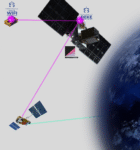At the AUSA 2025 exposition in Washington D.C., Moog Inc. unveiled a new lightweight variant of its Reconfigurable Integrated-weapons Platform (RIwP), designed to enhance the air defense capabilities of light tactical vehicles such as the Joint Light Tactical Vehicle (JLTV) and Infantry Squad Vehicle (ISV). The new LW-RIwP configuration is tailored to address the rising threat from Group 1–3 UAVs and low-flying helicopters in contested environments.
Modular Firepower for Short-Range Air Defense Missions
The Lightweight RIwP (LW-RIwP) is a scaled-down version of Moog’s combat-proven RIwP turret family. It retains the core modularity that allows users to tailor the turret’s weapon suite to specific mission profiles—ranging from kinetic counter-UAS roles to ground support. At AUSA 2025, the LW-RIwP was displayed configured with:
- A single M230LF 30×113 mm chain gun
- A pod of four Coyote Block 3 interceptors (developed by Raytheon)
- Electro-optical/infrared (EO/IR) sensors and radar cueing integration
This combination enables both hard-kill and soft-kill countermeasures against low-cost drones and loitering munitions. The M230LF provides precision fire against rotary-wing aircraft or ground targets, while the Coyote interceptors offer layered defense against Group 2–3 UAS threats at ranges up to ~10 km.
Designed for Lightweight Platforms Without Sacrificing Capability
The LW-RIwP is engineered specifically for integration on lighter platforms that cannot bear the weight or power demands of heavier SHORAD systems like IM-SHORAD on Stryker. According to Moog representatives at the show, the LW-RIwP weighs under one metric ton (~900 kg), including armament and sensors—making it compatible with vehicles such as:
- General Dynamics JLTV variants
- GM Defense ISV
- Oshkosh FMTV A2 platforms
This opens new possibilities for distributed SHORAD coverage across maneuver formations without requiring dedicated air defense battalions or heavy tracked systems.
Sensor Fusion and Network-Centric Targeting Integration
The LW-RIwP leverages open architecture principles to integrate with existing Army battle networks. It supports sensor fusion from onboard EO/IR systems, radar inputs via vehicle-mounted radars or external sources like KuRFS (Ku-band Radar Fire Control System), and cues from battlefield management systems such as FAADC2 or IBCS.
This networked approach allows operators to receive early warning of aerial threats beyond line-of-sight and engage them using either autonomous or semi-autonomous targeting modes. The turret also supports remote operation via crew stations inside the vehicle cabin or dismounted control units—a key feature for survivability in high-threat environments.
Counter-UAS Role Expands as Drone Threats Proliferate
The growing use of small drones by state and non-state actors has accelerated demand for mobile counter-UAS solutions that can be rapidly deployed across dispersed formations. The U.S. Army has fielded several interim C-UAS solutions under urgent operational needs programs since FY2019 but continues to seek scalable options suitable for brigade-level integration.
The LW-RIwP addresses this gap by offering a compact yet potent solution that bridges organic air defense at platoon/company level with broader theater-level systems like NASAMS or Patriot. Its compatibility with Raytheon’s Coyote Block 3—a semi-active radar-guided interceptor capable of engaging maneuverable drones—enhances its relevance in modern drone-saturated battlespaces such as Ukraine or Gaza.
Path Toward Fielding: Demonstrations and Procurement Outlook
Moog has conducted live-fire demonstrations of the LW-RIwP configuration at Yuma Proving Ground throughout late FY2024 under Army Rapid Capabilities Office sponsorship. While no formal program-of-record exists yet for this exact configuration, it aligns closely with ongoing U.S. Army efforts under Increment II of Mobile-Low Slow Small Unmanned Aircraft System Integrated Defeat System (M-LIDS).
Industry observers suggest that if successful in further testing—including reliability trials under conditions simulating GPS jamming and EW interference—the LW-RIwP could be fielded via Directed Requirement pathways or integrated into future JLTV modernization packages post-FY2026.
Conclusion: Lightweight SHORAD Evolves Toward Modularity and Mobility
The unveiling of Moog’s lightweight RIwP turret at AUSA 2025 underscores a broader trend within NATO militaries toward distributed short-range air defense solutions that can keep pace with fast-moving ground forces while countering increasingly diverse aerial threats. By combining kinetic interceptors like Coyote Block 3 with proven autocannons in a modular package suitable for light vehicles, Moog positions itself as a contender in next-generation mobile air defense architectures.










